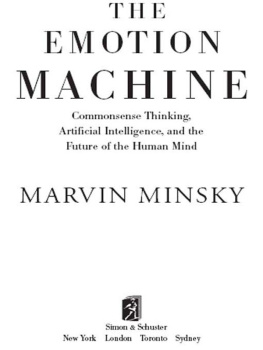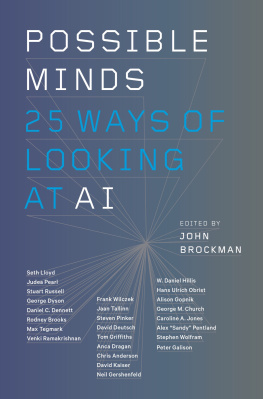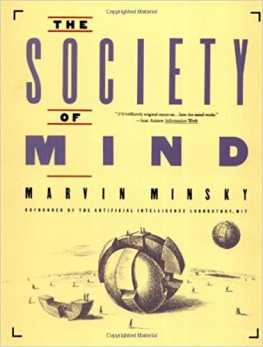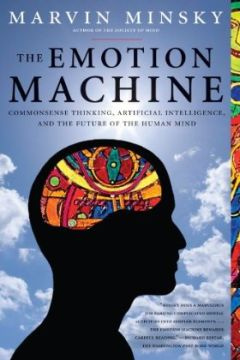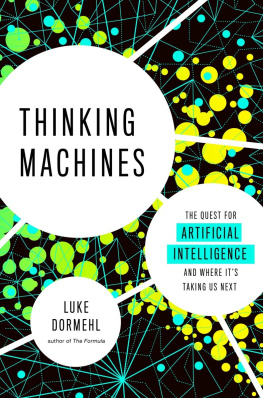R. J. Solomonoff
Andrew M. Gleason
George A. Miller
J. C. R. Licklider
Warren S. McCulloch
Claude E. Shannon
INTRODUCTION
Nora Joyce, to her husband James: Why dont you write books people can read?
I hope this book will be useful to everyone who seeks ideas about how human minds might work, or who wants suggestions about better ways to think, or who aims toward building smarter machines. It should be useful to readers who want to learn about the field of Artificial Intelligence. It should also be of interest to psychologists, neurologists, computer scientists, and philosophers because it develops many new ideas about the subjects those specialists struggle with.
We all admire great accomplishments in the sciences, arts, and humanitiesbut we rarely acknowledge how much we achieve in the course of our everyday lives. We recognize the things we see, we understand the words we hear, and we remember things that weve experienced so that, later, we can apply what weve learned to other kinds of problems and opportunities.
We also do a remarkable thing that no other creatures seem able to do: whenever our usual ways to think fail, we can start to think about our thoughts themselves and if this reflective thinking shows where we went wrong, that can help us to invent new and more powerful ways to think. However, we still know very little about how our brains manage to do such things. How does imagination work? What are the causes of consciousness? What are emotions, feelings, and thoughts? How do we manage to think at all?
Contrast this with the progress weve seen toward answering questions about physical things. What are solids, liquids, and gases? What are colors, sounds, and temperatures? What are forces, stresses, and strains? What is the nature of energy? Today, almost all such mysteries have been explained in terms of very small numbers of simple lawsfor example, the equations discovered by such physicists as Newton, Maxwell, Einstein, and Schrdinger.
So naturally, psychologists tried to imitate physicistsby searching for compact sets of laws to explain what happens inside our brains. However, no such simple set of laws exists, because every brain has hundreds of parts, each of which evolved to do certain particular kinds of jobs; some of them recognize situations, others tell muscles to execute actions, others formulate goals and plans, and yet others accumulate and use enormous bodies of knowledge. And though we dont yet know enough about how each of those brain-centers works, we do know their construction is based on information that is contained in tens of thousands of inherited genes, so that each part of the brain works in a way that depends on a somewhat different set of laws.
Once we recognize that our brains contain such complicated machinery, this suggests that we need to do the opposite of what those physicists did: instead of searching for simple explanations, we need to find more complicated ways to explain our most familiar mental events. The meanings of words like feelings, emotions, or consciousness seem so natural, clear, and direct to us that we cannot see how to start thinking about them. However, this book will argue that none of those popular psychology words refers to any single, definite process; instead each of those words attempts to describe the effects of large networks of processes inside our brains. For example, Chapter 4 will demonstrate that consciousness refers to more than twenty different such processes!
It might appear to make everything worse, to change some things that looked simple at first into problems that now seem more difficult. However, on a larger scale, this increase in complexity will actually make our job easier. For, once we split each old mystery into parts, we will have replaced each old, big problem with several new and smaller oneseach of which may still be hard but no longer will seem unsolvable. Furthermore, Chapter 9 will argue that regarding ourselves as complex machines need not diminish our feelings of self-respect, and should enhance our sense of responsibility.
To start dividing those old big questions into smaller ones, this book will begin by portraying a typical brain as containing a great many parts that well call resources.

Well use this image whenever we want to explain some mental activity (such as Anger, Love, or Embarrassment) by trying to show how that state of mind might result from the activities of a certain collection of mental resources. For example, the state called Anger appears to arouse resources that make us react with unusual speed and strengthwhile suppressing resources that we otherwise use to plan and act more prudently; thus, Anger replaces your cautiousness with aggressiveness and trades your sympathy for hostility. Similarly, the condition called Fear would engage resources in ways that cause you to retreat.
Citizen: I sometimes find myself in a state where everything seems cheerful and bright. Other times (although nothing has changed) all my surroundings seem dreary and dark, and my friends describe me as down or depressed. Why do I have such states of mindor moods, or feelings, or dispositionsand what causes all of their strange effects?
Some popular answers to this are, Those changes are caused by chemicals in the brain, or They result from an excess of stress, or They come from thinking depressing thoughts. However, such statements say almost nothing about how those processes actually workwhereas the idea of selecting a set of resources can suggest more specific ways in which our thinking can change. For example, Chapter 1 will begin by thinking about this very familiar phenomenon:
When a person you know has fallen in love, its almost as though someone new has emergeda person who thinks in other ways, with altered goals and priorities. Its almost as though a switch has been thrown and a different program has started to run.

